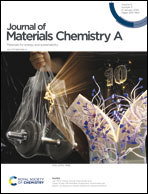Tailoring composite gel polymer electrolytes with regularly arranged pores and silica particles for sodium metal batteries via breath-figure self-assembly†
Abstract
Sodium (Na) metal batteries offer a promising alternative to lithium (Li) counterparts, leveraging the abundant and cost-effective nature of Na metal. However, the development of optimized separators and polymer electrolytes remains essential for Na metal systems. Herein, we propose a novel approach to prepare composite gel polymer electrolytes by embedding regularly distributed silica particles within a porous poly(vinylidene fluoride-co-hexafluoropropylene) (PVH) matrix through static breath-figure self-assembly. This method enables the incorporation of high silica particle loadings, up to 70 wt%, ensuring thermal and mechanical stability, high ionic conductivity, and effective suppression of Na dendrite formation. Post-mortem analyses, employing in-depth X-ray photoelectron spectroscopy (XPS) and time-of-flight secondary ion mass spectrometry (TOF-SIMS), offer valuable insights into how these composite gel polymer electrolytes influence the cycling performance of Na metal batteries. This study presents a straightforward and efficient strategy for fabricating composite gel polymer electrolytes to enhance the performance of Na metal batteries.



 Please wait while we load your content...
Please wait while we load your content...